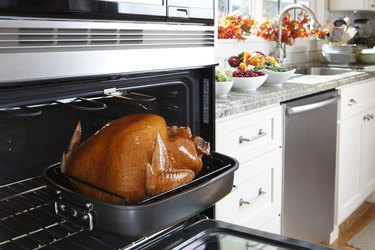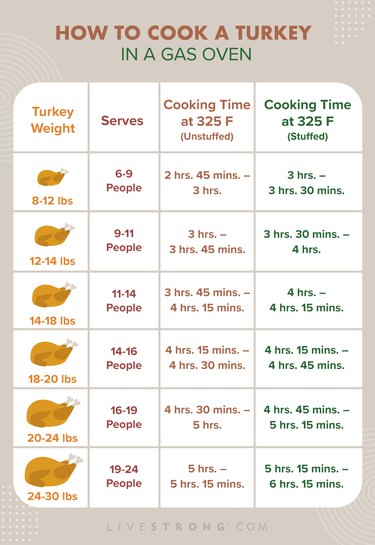
While turkey hits the peak of its popularity around Thanksgiving, this type of poultry can be cooked for a delicious meal any time of year.
Most commonly, people opt to bake a turkey in the oven — and the process is mainly the same regardless of whether you have a gas or electric oven. Still, in many gas ovens, there are both hot and cold spots, as the heat doesn't circulate evenly — which means when you check on your turkey as it cooks, you'll want to make sure to rotate your roasting pan.
Video of the Day
Video of the Day
Here's what you need to know to cook a delicious turkey safely.
What to Do if Your Turkey Is Frozen
It's very common to purchase a frozen — not fresh — turkey. If your turkey is frozen, you'll need to defrost it before cooking. This is a time-consuming process, so make sure to plan ahead.
There are only three safe ways to defrost a turkey, per the USDA:
- Thaw it in the fridge. For every 5 pounds of weight, it'll take 24 hours to thaw, per the USDA. That means a 10-pound turkey, for instance, will take 2 full days to defrost. Yes, this method takes a while, but it's the USDA's most-recommended option because it's both safe and easy.
- Thaw it in cold water. Submerge the turkey in its original packaging in cold tap water. You can do this in the sink or a bucket; the sink may be ideal as you'll need to change out the water every 30 minutes, per the USDA. Timing-wise, this thawing method requires around 30 minutes per pound — so a 10-pound turkey will take around 5 hours to defrost.
- Thaw it in the microwave. This is the fastest method, but also the trickiest. First, you'll need to confirm the turkey fits in the oven. If it does, remove the wrapping and place the turkey on a microwave-safe dish and follow the instructions on the microwave's defrost function, per the USDA — rotate and flip the bird throughout the process. If the turkey starts cooking, let it rest. You'll need to cook the bird immediately after it's defrosted in the microwave. This takes about 6 minutes per pound. A 10-pound turkey will take around an hour to defrost.
Food Safety Tips for Cooking a Turkey
To avoid foodborne illness, take food safety seriously as you prep and cook your turkey, and again when you store leftovers. Here are tips to keep in mind:
- Wash your hands. Before handling the turkey — or cooking any food, for that matter — wash your hands with soap and hot water, per the Centers for Disease Control and Prevention (CDC). You'll also want to wash them after touching uncooked poultry.
- But don't rinse the bird. That's because doing so can splash bacteria throughout your kitchen and even potentially land on other prepared foods, according to the USDA.
- Thaw the turkey safely. Never, ever thaw a turkey on the countertop. Follow only the three strategies mentioned above to defrost a turkey.
- Handle the turkey properly. Utensils, cutting boards and anything else that touches an uncooked turkey should be washed after use, according to the CDC.
- Cook the bird until it's done. You'll know the bird is fully cooked when a food thermometer reports a temperature of 165 degrees Fahrenheit when it's placed at the innermost part of the thigh, the innermost part of the wing and the thickest part of the breast, per the USDA.
- Don't dilly-dally with leftovers. Whatever you don't eat (and want to eat later) should be placed in small, shallow containers within 2 hours of the meal, per the CDC — this allows them to cool down quickly. Remove the meat from the bone, and eat refrigerated leftovers within 4 days, according to USDA. Freezing leftovers is also an option; you can eat these for up to 6 months.
How to Cook a Turkey in a Gas Oven
Gas ovens are quick to heat — a bonus when you're preheating.
But unlike electric ovens, they can be prone to issues with heat distribution, according to Whirlpool. Having a cold or hot spot in the oven isn't ideal when you're cooking a large bird. To avoid issues, rotate your roasting pan occasionally.
Other than that, cooking a turkey in a gas oven is the same as in an electric one.
Things You'll Need
Turkey
Water (optional)
Food-safe bucket or sealable bag that fits the turkey (optional)
Kosher salt (optional)
Roasting pan
Aluminum foil
Cotton butcher’s twine
Vegetable or olive oil or butter
Salt
Pepper
Root vegetables (optional)
Liquid (water or chicken stock)
Food thermometer
Step 1: Thaw your turkey according to the strategies listed above. Skip this step if your bird is fresh, not frozen.
Step 2 (optional): "Brining a turkey ensures a moist, seasoned finished product," King Phojanakong, a chef at the Institute of Culinary Education, tells LIVESTRONG.com. To brine a turkey, follow these steps:
- Create a saltwater brine made from 1 cup kosher salt to every gallon of water, per the National Turkey Federation (NTF).
- Add spices and herbs to the mixture for additional flavor (optional).
- Place the liquid in a food-safe bucket or sealable bag. Submerge the turkey in the liquid.
- Put the container in the refrigerator for at least 8 hours and up to a full day.
Step 3: Preheat the oven to 325 degrees Fahrenheit (gas mark 3).
Step 4: Remove the turkey from its packaging. Reach in, and remove the bag with giblets.
Step 5: Truss (tie up) the turkey, using cotton butcher's twine — there are different ways to approach this but the basic goal is to keep the legs and wings secure, per NTF.
"Trussing not only helps to keep the turkey's shape but also keeps the wings and legs close to the body preventing it from drying out," Phojanakong says. Alternatively, you can tuck the wings under the turkey and close the legs.
Step 6: Rub vegetable or olive oil — or butter — all over the turkey. "Basically any type of fat will work here," Phojanakong says, noting he's used strips of bacon as well. Sprinkle with salt and pepper.
Step 7: Place the bird on a roasting rack in the roasting pan. If you don't have a roasting rack, rest the bird on top of root vegetables, Phojanakong suggests. "Lifting the turkey off the bottom will ensure that the turkey will be evenly cooked," he says. You can scatter root vegetables at the bottom of the pan if you'd like, even if you do have a roasting rack.
Step 8: Add some liquid to the bottom of the pan.
Step 9: Use aluminum foil to tent the turkey.
Step 10: Cook your turkey according to its weight. The chart below will help you determine your bird's time in the oven.
Step 11: About 30 to 45 minutes before your turkey is fully cooked, remove your aluminum foil tent, Phojanakong says. Then, baste the bird. "You can add more fat on the turkey as well to ensure a crispy skin," he says.
Step 12: To check if the turkey is done, place a food thermometer on the innermost part of the thigh and the thick part of the breast. "Poultry is safe to eat when it reaches an internal temperature of 165 degrees Fahrenheit," Phojanakong says.
Step 13: Remove the turkey from the oven. Let it rest 10 to 15 minutes before carving and serving, per the NTF.
Tip
To confirm that the temperature in your oven is accurate, it can be helpful to keep a high-temperature oven thermometer ($7, Amazon.com) inside it, Phojanakong recommends.
How Long to Cook Your Turkey
A little bit of math is required to cook a turkey. First comes the question of how big a bird you'll need: While you can go with 1 pound (uncooked) per person, 1.25 pounds per person will ensure that everyone can have seconds, per the NTF.
Then, there's the question of how long your bird needs to cook — the bigger the bird, the more time it'll need in the oven.
This chart outlines the information you'll need when it comes to size and cooking time at 325 F (gas mark 3).
Turkey Weight | Servings | Cooking Time in Gas Oven | Cooking Time in Gas Oven (Stuffed) |
|---|---|---|---|
8-12 pounds | 6-9 servings | 2 hrs. 45 mins. - 3 hrs. | 3 hrs. - 3 hrs. 30 mins. |
12-14 pounds | 9-11 servings | 3 hrs. - 3 hrs. 45 mins. | 3 hrs. 30 mins. - 4 hrs. |
14-18 pounds | 11-14 servings | 3 hrs. 45 mins. - 4 hrs. 15 mins. | 4 hrs. - 4 hrs. 15 mins. |
18-20 pounds | 14-16 servings | 4 hrs. 15 mins. - 4 hrs. 30 mins. | 4 hrs. 15 mins. - 4 hrs. 45 mins. |
20-24 pounds | 16-19 servings | 4 hrs. 30 mins. - 5 hrs. | 4 hrs. 45 mins. - 5 hrs. 15 mins. |
24-30 pounds | 19-24 servings | 5 hrs. - 5 hrs. 15 mins. | 5 hrs. 15 mins. - 6 hrs. 15 mins. |
Should You Stuff a Turkey?
Phojanakong recommends against stuffing a turkey. So does the USDA. If you do opt to stuff your bird, you may need to cook the turkey for longer — the stuffing inside the turkey will need to reach 165 degrees Fahrenheit. That can occur after the bird’s cooked, so it can lead to dried-out turkey.

- USDA: "The Big Thaw for Thanksgiving"
- USDA: "How to Safely Thaw a Turkey"
- Centers for Disease Control and Prevention: "Food Safety Tips for Your Holiday Turkey"
- USDA: "Tips and Resources for a Bacteria-Free Thanksgiving"
- USDA: "Thanksgiving Leftovers for Safe Keeping, Weekend Grazing"
- National Turkey Federation: "Time to Brine Your Turkey"
- NTF: "How to Grill a Holiday Turkey"
- NTF: "Tips for Roasting a Turkey"
- NTF: "How Much Turkey for My Table?"
- NTF: "Cooking Turkey"
- USDA: "Countdown to a Food-Safe Thanksgiving Day - FAQs"
- Whirlpool: "Gas vs. electric stoves: what’s the difference?"